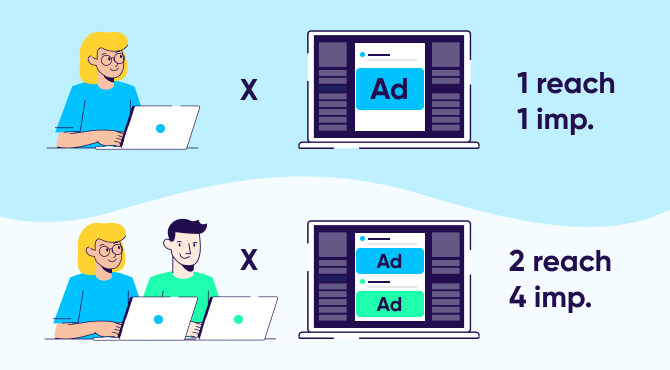
Ad impression
Ad impressions indicate the number of times an ad is displayed within an app. They’re different from ad clicks, as the number of impressions does not reflect the number of times the ad was clicked.

What is an ad impression?
An ad impression, also known as an ad view, quantifies the number of digital views an advertisement, post, or web page receives. It’s a numerical value that tells you how many sets of “eyeballs“ have potentially viewed your content.
There has been some debate about the accuracy of ad impressions as a metric, as they don’t reflect whether a viewer actually interacted with the content. Regardless, impressions remain one of the most critical digital marketing metrics out there.
Why? Because they tell us how many potential customers have been exposed to a piece of content. And that’s priceless information for marketers.
The two types of ad impressions
Ad impressions can be classified under the following two categories:
1. Served impressions
Served impressions tell you how many times your ad has been delivered to a web page by the ad server. This is the most common way of measuring impressions and is often used as a baseline metric for ad campaigns.
But, there’s a catch: even if the ad isn’t visible to users (for example, it’s buried below the fold), the ad server will still count it as a served impression. So, you can sometimes get a false impression of how many people are seeing your ad.
2. Viewable impressions
Viewable impressions measure the actual number of times your target audience sees the ad.
The Media Rating Council and Interactive Advertising Bureau base viewable impressions on a pixel metric and a time metric. As per the body, an impression is considered viewable when:
- at least half of the content asset is on an active, open browser tab and viewable on the page; and
- the pixel standard lasts for at least one second so a potential viewer sees it after the ad loads.
Served impressions help you understand an ad campaign’s reach, but If you really want to gauge its impact on your target audience, you need to look at viewable impressions. But here’s the catch: not all ad servers count viewable impressions, which makes tracking them slightly more challenging for website owners and advertisers.
Nevertheless, both metrics have a place in the world of digital advertising to help you make informed decisions about your campaigns and ensure your message is getting through to the right audience.
Ad impressions vs. ad clicks vs. ad reach
Yup, all three are different terms and cannot be used interchangeably. Let’s review how impressions differ from clicks and reach.
Ad impressions vs. ad clicks
Ad clicks count the number of times users engage with your ad by clicking on it.
Impressions give you an idea of how many people have seen your ad, but clicks are where the real action happens. Clicks show how many people are actually interested in your product or service and take action to learn more.
Let’s say you’re running a Facebook ad campaign targeting young women aged 18-24, and you see that your ad has been seen 10,000 times but only received 100 clicks.
While 10,000 impressions are great, 100 clicks are not, resulting in a click-through rate (CTR) of just 1%. It’s clear your ad isn’t resonating with your target audience as much as you’d like it to.
Ad impressions vs. ad reach
Ad reach measures the number of unique individuals who see your ad, indicating a higher level of interest in the advertised product or service.

Reach gives you a more accurate picture of your ad’s impact by showing you how many people are viewing your ad and are potentially interested in your product or service. In contrast, impressions do not indicate the level of interest or engagement with the ad.
Let’s say you’re promoting a new healthy drink on social media.
If your ad has 1,000 impressions, that just means it was displayed 1,000 times — it doesn’t necessarily mean 1,000 different people saw it. But if your ad has a reach of 500, that tells you that 500 unique individuals have seen it and are potentially interested in what you’re offering.
Why are ad impressions important?
Ad impressions may not necessarily indicate interest or engagement with an ad, but they are an important tool for marketers, enabling them to measure the reach and impact of their campaigns — or how many people are exposed to their ads.
They’re relevant to multiple disciplines and tasks in the mobile marketing niche, including:
User acquisition campaigns
As a marketer, you know that acquiring new users is crucial for your app’s success. That’s where impressions come in, as the more impressions your ad gets, the more likely it is that you’ll acquire new users for your app.
Let’s say you’re launching a user acquisition campaign for a fitness app.
You create a series of eye-catching banner ads aimed at health enthusiasts. By monitoring impressions, you can keep track of how many times these ads have been served and check the click-through rate to gauge their effectiveness.
And that’s not all. With this data, you can optimize your ads by tweaking their placement, modifying the target audience, or even changing their design.
App store optimization (ASO)
ASO involves optimizing various elements of an app’s listing in the app store to improve its visibility and discoverability, ultimately leading to increased downloads.
Impressions data is a key component of ASO, as it helps app developers and marketers understand how often their app is being viewed by potential users.
For example, if an app developer notices their app is receiving a high number of impressions but their download rate is low, the developer can focus on optimizing the app’s meta description (think: the app’s title, description, and keywords) so that it appeals to more people and attracts more downloads.
In addition, impressions data can help marketers identify the keywords or phrases that are driving the most impressions. Armed with this information, they can optimize the app’s metadata with the most relevant and high-traffic keywords to increase its visibility in the app store search results.
Creative optimization
Advertisers should optimize their ad creatives regularly to improve performance and user engagement.
By analyzing your ad’s performance, making necessary tweaks, and measuring the impact of those changes, you’ll see a marked improvement in the effectiveness of your ads. And what better way to analyze ad performance than by using impression data?
This data helps you calculate important metrics such as CPM (cost per mille — more on this below) and CTR, giving you a better understanding of how well your ad is resonating with your audience. For example, if your video ad has a high CPM but a low CTR, you may want to adjust the video’s length or content to improve its effectiveness.
How advertisers and publishers use ad impressions

Impressions are crucial to advertisers for the following reasons:
- Offer insights into the performance of ads within a specific channel
- Help determine the reach of an advertising channel, which is essential for evaluating the effectiveness of an ad campaign
- Required to accurately calculate click-through rate (CTR)
- Help optimize ads and their placement
- Calculate the cost of a cost per mille (CPM) campaign.
Impressions are crucial to publishers for the following reasons:
- Calculate the effective cost per mille (eCPM), which is the payment model used to compensate publishers for ad space. By using impressions data, publishers can determine how much they’re monetizing their traffic and optimize their revenue streams accordingly.
- Analyze the number of people viewing their ads and the revenue generated from ad space on their website. This data is valuable for optimizing ad space, increasing revenue, and identifying areas for improvement.
Ad impression and mobile marketing metrics
Ad impressions play a significant role in optimizing mobile marketing campaigns. This is because they’re closely tied to the following three key metrics that aid in the optimization process:
1 — Click-through rate
Click-through rate (CTR) measures the percentage of ad impressions that leads a user to click on your ad. This metric is particularly useful to determine the effectiveness of your ad campaigns and make data-driven decisions related to ad optimization.
For example, let’s suppose a banner ad running on a social media platform received 10,000 impressions and 300 clicks, resulting in a CTR of 3%. Based on this data, you can determine if the results are what you want and make appropriate changes to the ad’s design, message, or placement to improve performance.
A higher CTR indicates more user relevance and engagement, while a lower CTR suggests you may need to optimize the ad.
2 — Cost per mille
Cost per mille (CPM) calculates the cost of 1000 ad impressions.

You can use CPM to understand how much you’re paying to reach a specific audience and compare the cost of different ad placements. It’s also useful to calculate the return on investment (ROI) of an ad campaign and make data-driven decisions about budget allocation.
Imagine you‘re running a CPM campaign to promote your app’s premium subscription service.
If you pay $10 per 1,000 impressions and get 50,000 impressions, your total campaign cost comes to $500. Based on the conversions generated from the campaign, you can determine the ROI and decide if the campaign was successful and if the cost is justified.
3 — Effective cost per mille
Effective cost per mille (eCPM) measures the average revenue earned per 1,000 ad impressions displayed on your app. You can calculate this by dividing total revenue by the number of impressions and then multiplying the number by 1,000.
You can use this metric to evaluate the performance of each campaign without jeopardizing reach. It also indicates whether you’re using the most effective buying model to optimize campaign performance and revenue stream.
For example, if you have an ad space that generates 100,000 impressions monthly and you earn $500 in total revenue from it, the eCPM from the ad space is $5 (calculated by dividing $500 by 100,000 impressions and then multiplying by 1,000).
You can use this data to determine if the ad space is generating enough revenue or whether you should make changes to optimize it further.
How does an ad impression work?
Ad impressions are like the eyes of the digital advertising world.
Ad servers assign a small pixel to a web page, and an impression is registered whenever the pixel loads. However, there are limitations to this approach, as each impression doesn’t guarantee a new user saw or interacted with the ad, leading to impression fraud.
To optimize ad impressions, marketers can target specific audiences and create appealing ad creatives. For instance, you can target users who have downloaded similar games in the past and use captivating ad creatives to drive clicks and installs.
Limiting the frequency of ad displays is also useful to avoid overloading users with the same ad repeatedly, thereby improving the ad’s overall effectiveness.
Key takeaways
- Ad impressions quantify the number of digital views an advertisement or web page receives, indicating how many sets of “eyeballs“ have potentially viewed your content.
- Ad impressions can be classified as served impressions (number of times an ad is delivered to the web page by the ad server) and viewable impressions (actual number of times your target audience sees the ad). Viewable impressions are more accurate than served impressions when it comes to measuring ad effectiveness.
- Ad impressions are not the same as ad clicks, which count the number of times users click on an ad, demonstrating their interest or engagement.
- Marketers can use impressions data to measure the reach and impact of their campaigns. It’s also useful for optimizing user acquisition campaigns and analyzing ad engagement to make informed campaign decisions.



